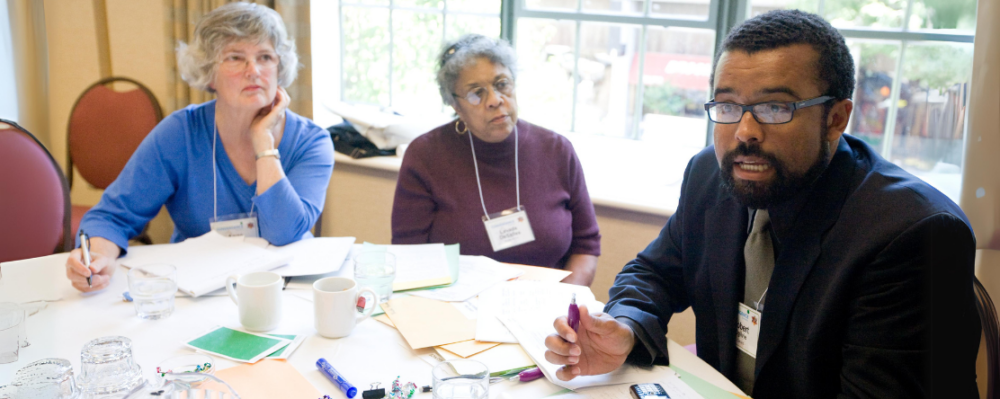
Advancing Equity: Adapting to Local Context and Confronting Power Dynamics—Lessons Learned from ACHs
- Sue Grinnell, BS, MPH
- Stephanie Bultema, Peter Forberg
-
Focus Areas
Healthy Communities -
Issues
Population Health -
Expertise
Research – Survey -
Programs
Population Health Innovation Lab (PHIL)

Accountable Communities for Health (ACHs) are collaborative partnerships spanning health, public health, social services and communities, which collectively improve health by addressing issues such as housing, food security, employment, and transportation.
This report, released by PHI’s Population Health Innovation Lab (PHIL), shows how six ACHs across California and Washington are levelling differences in power dynamics and improving equity in communities. It summarizes a deeper dive into the research findings for six ACHs operating in rural, urban, and diverse regional contexts, and examines the barriers to implementation and opportunities for success. It also provides resources for how communities can tackle these challenges head-on to collectively build health, equity and community power.
Read the report
How local context and power dynamics influence an ACH’s ability to make progress toward improved equity
- Local context shapes how aligning works. What works in one context may not work in another. Gaining a deep understanding of the local context and adjusting the approach to match will increase the chances of successful aligning.
- Power dynamics influence how people, organizations, sectors, and groups interact. ACHs are uniquely positioned to balance power dynamics by facilitating power sharing. However, caution and careful attention is needed since ACHs can also reinforce or exacerbate existing power imbalances in communities.
- ACHs are making progress toward equity by normalizing equity concepts, shifting mindsets and practices, and providing equity education. Many ACHs are focused on equity in a way that likely would not be present in their communities without them. ACHs are laying a strong foundation for future equitable practices in communities.
- The most pressing challenges are figuring out how to move from equity ideas to measurable progress and how to fund equity efforts.
A lot of these folks will just chalk it up to [the county] as poor white conservative rural county. And that’s just objectively not true. You know, of the 65,000 people who live here, 20,000 of them are non-white, and I think are just left out of a lot of these conversations.ACH Participant
Backbone Staff, California
How do we authentically engage community to help solve problems and address challenges? Communities might not define challenges in the same way or might even have a different way of thinking about the challenges than we would. We need to understand from a community’s perspective. It’s about the agency of individuals.Gena Morgan
Staff, HealthierHere
And that’s what bothers me; that goes back to equity. I don’t think this is totally complicated. There are simple things we can try. But somehow, we’re all into the weeds, and we can’t see the picture. And that’s what I’m hoping the ACH can do. Get us out of the weeds and start looking at the forest rather than just the trees.ACH Participant
Healthcare Sector, California
Recommendations
Local Context
- Gain an intimate understanding of the local context and take time to learn how aligning works within it. This could mean surveying residents or hard-to-reach communities, using network mapping to gain an understanding of the local system, partnering with health care and public health organizations on community health needs assessments, and/or including community representatives in a collaborative process through informal (e.g., listening sessions) or formal roles (e.g., governing or advisory committee members). Ensure actions are informed by knowledge of the local context. Train new partners and staff on the ACH’s local context, including any history of conflict and collaboration between different groups in the community.
- Partner with local tribes or other Native American groups to provide ACH participants—including organizations and individuals representing communities and sectors—with education on Native American history, customs, and approaches to community health and well-being. This could mean working with tribal representatives for training or consultation on topics such as tribal sovereignty, land acknowledgement, tribal history, traditional medicine, and prevention approaches.
- Leverage the power of the ACH network to help communities respond to and recover from public health emergencies. This could mean pragmatically (e.g., coordinating cross-sector efforts to plan for and respond to emergencies) or socially (e.g., building community connectedness) so that resources and support can more easily and efficiently reach those in need.
- Provide Neutral Spaces that encourage communities to develop shared understanding and approaches to address complex topics like equity and racism. This could mean hosting community conversations (e.g., to process complex events like racially motivated violence) or helping partner organizations understand where they can improve (e.g., by providing equity training or facilitating equity assessments).
Power Dynamics
- Be mindful of power dynamics, since they can help or hinder ACH goals. At the ACH level, this could mean assessing the makeup of the ACH’s governing board and committees; at the community level, it could mean assessing where ACH investments are being made; and, at the regional or state level, who is contributing to planning and decision making?
- Explore and implement strategies for shifting power from traditionally powerful actors (e.g., health care, government, business) to actors with less power (e.g., community residents, community-based organizations, tribal nations, and other indigenous groups). Formal arrangements and diverse representation are effective strategies to building power sharing and equitable processes into aligning. This could mean creating community advisory boards, designating governing seats for historically marginalized actors, and/or ensuring meetings and meeting materials are easily accessible to all participants.
- Explore and implement strategies for ensuring equity and transparency in decision making. Examples include using voting cards that are publicly displayed by all people contributing a decision; using participatory budgeting principles; establishing a group of community residents who work closely with ACH leadership to inform decision-making; designating board seats for representatives of less powerful groups; and/or, informing participants about how funds are prioritized and allocated.
Equity
- Keep the focus on equity throughout all ACH activities. This could mean developing and tracking equity measures, naming equity in the ACH mission and vision statements, building an explicit equity component into every project or intervention, and/or incorporating an equity requirement into partner agreements (e.g., participation in trainings or integration of equity measures in workplans).
- Create equitable processes. This could mean intentionally bringing marginalized groups (e.g., tribes, immigrant communities, communities of color) into decision making, adding equity check-ins or joint reflections as a standing meeting agenda item, ensuring meeting times and locations are conducive to participation for all partners, offering a remote meeting option, and/or providing foundational education to people who may not be familiar with a topic (e.g., Medicaid billing fundamentals, managed care organizations, medical terminology, etc.).
- Look for opportunities to educate partners and community members on equity concepts. This could mean the ACH is directly providing education, partnering with organizations or community groups to provide education, or sharing existing resources with ACH partners. Some ACHs have integrated equity education into their operations through equity-focused reading groups, developing equity frameworks, or integrating new approaches like use of the targeted universalism framework, human-centered design, or Art of Hosting into their work.
Additional Contributors
- Stephanie Bultema, PhD
- Peter Forberg, MA
- Sue Grinnell, MPH
Work With Us
You change the world. We do the rest. Explore fiscal sponsorship at PHI.
Support Us
Together, we can accelerate our response to public health’s most critical issues.
Find Employment
Begin your career at the Public Health Institute.


